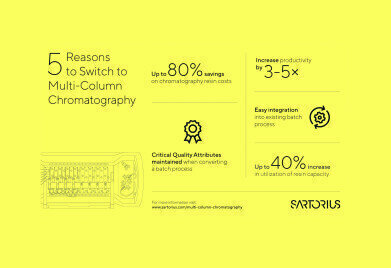Columns (LC)
How Multi-Column Chromatography Improves Downstream Processing and Saves Money
Jul 26 2022
One of the most time-consuming and resource-consuming parts of every bioprocess is downstream processing, particularly at the capture step. The traditional capture chromatography method for processing (single-column approach) requires a lot of time, equipment, and resin, keeping costs high and resulting in production bottlenecks in a very time-sensitive industry.
With the BioSMB multi-column chromatography platform you can get the best of both worlds. It offers significant savings without sacrificing any of the quality you expect, using essentially the same process in a more efficient way.
Multi-column chromatography (MCC) is currently one of the leading routes to optimize the downstream capture steps. Here are just a few reasons why you should start using MCC today:
1: Reduce Waste and Cut Costs
Manufacturing companies throughout the world have a common goal: relentlessly eliminate waste to create the most efficient process. In downstream processing the resin represents a significant portion of the costs for single-column chromatography batch processes. However, at any given time with a single-column approach, only a small amount of the resin in the column is actually doing its job. The rest sits idle without being fully utilized and is eventually thrown away.
A better alternative is multi-column chromatography, which uses multiple small columns. These columns are cycled much more frequently utilizing the resin fully. When you do more with less you can achieve up to 80% savings on chromatography resin costs with MCC. The MCC system is a direct replacement for a single column system.
2: Eliminate Bottlenecks:
Single-column chromatography facilities often limit throughput because using more resin to speed up the process costs more. Using less resin saves money, but it slows down the process and creates a bottleneck.
With multi-column chromatography each column is fully loaded, then once it’s complete that column can begin the purification process, which continues with each column cycling through various different stages in parallel. You get a more efficient process by performing multiple steps at the same time and increase productivity by 3-5x over single-column chromatography.
3: Maintain Quality Attributes and Performance
Facilities still using single-column chromatography might wonder whether making these changes to the process would negatively impact quality. The switch from the standard large single column to multiple smaller columns is different, and the concept of column overload is new in most facilities. But neither will negatively impact quality attributes, so you get the same quality with more efficiency, all while reducing costs.
4: Avoid Adding More Hardware
The MCC system enables the use of much smaller columns. You can configure as many or as few columns as needed to optimize your manufacturing process. But the size burden is always less, as is the storage and packing overhead. MCC systems eliminate the need for costly and large ancillary hardware traditionally required with conventional single-column approaches.
Learn more about how MCC works in downstream processing and talk to the Sartorius team about how this innovative method could improve your pharmaceutical manufacturing processes.
Digital Edition
Chromatography Today - Buyers' Guide 2022
October 2023
In This Edition Modern & Practical Applications - Accelerating ADC Development with Mass Spectrometry - Implementing High-Resolution Ion Mobility into Peptide Mapping Workflows Chromatogr...
View all digital editions
Events
ACS National Meeting - Fall 2024
Aug 18 2024 Denver, CO, USA
Sep 04 2024 Chiba, Tokyo, Japan
Sep 04 2024 University of Warwick, Coventry, UK
Sep 10 2024 Rockville, MD, USA
Plastics Recycling World Expo Europe
Sep 11 2024 Brussels, Belgium














